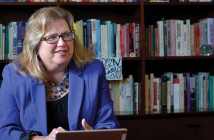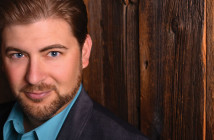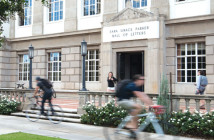The recent public discourse on the liberal arts questions the value of an education that does not directly set out to prepare students for a profession. Meanwhile, liberal arts institutions are left to question their own purpose to both students and to society as a whole.
The life of a university is one of constant motion. From fall to spring, a fixed cycle of routines and time-honored traditions keeps the academic calendar moving forward from one term to the next, for nine months straight, year after year. Summer offers a needed pause, but the whoosh of energy and excitement every September jolts the cycle back into motion—suddenly, residence halls buzz with conversation, quads fill with activity, pages turn in libraries and pens scribble furiously in lecture halls.
At colleges and universities across the country, thousands of returning students are settling into the fall semester and many others are beginning their undergraduate educational journeys. This fall, Redlands welcomed 538 first-year students and 111 transfer students. Like the 40,000 alumni before them, they arrived on campus open to new possibilities and ready for the next stage of their lives.
In coming to the University of Redlands, our undergraduate students have chosen to spend their early adult years pursuing a liberal education in the College of Arts and Sciences. This fact alone may not seem extraordinary—they follow generations of students before them—and yet, in light of the current national dialogue on the value of a liberal education, this decision in 2015 is significant.
In his 2014 Sarah Lawrence College commencement address, journalist Fareed Zakaria jocularly summarized the current mood, telling students, “you are graduating … at an interesting moment in history—when the liberal arts are, honestly, not very cool. You all know what you’re supposed to be doing these days—study computer science, code at night, start a company … what you’re not supposed to do is get a liberal arts education.” How did this happen? Were previous generations of liberal arts graduates wrong?
The start of the academic year provides an ideal time to reflect and consider this “interesting moment in history” and the big, if basic, questions it raises: What do we mean when we talk about the “liberal arts”? What is a “liberal education,” and why do students return every fall to pursue one? In an age when technology and globalization dominate our economy and our personal lives, what is the role of the liberal arts university?
What We Talk About When We Talk About the Liberal Arts
To understand the current challenges confronting the liberal arts, we must first unravel some of the confusion surrounding the term itself. As Gerald Greenwald, a linguist and associate dean at Syracuse University points out (in an April 2015 article in The Washington Post by Valerie Strauss), discussions about the value of the liberal arts have the tendency to become “confused and unfocused,” because “different people have a different understanding of what the term means.” While there is certainly no shortage of ink or breath devoted to the topic right now, as Greenwald suggests the discussions are a jumble of different meanings, ideas, experiences and opinions. In recent years, “liberal arts” has become a buzzword, a catchall term regularly used by figures in the media and political arena to describe anything that is not pre-professional education. The term also is used interchangeably with “liberal education,” or is conflated with the humanities—learning largely concerned with human culture.
Discussions based on this ubiquitous general understanding tend to be divisive, devolving into either/or
debates that do little to fully describe or engage an idea that began in classical Greece, traveled throughout the first universities in Europe and landed in the U.S., where it grew rapidly. Knowing what we mean when we talk about the liberal arts matters, because when we gloss over its true meaning, we risk misunderstanding the mission of a liberal arts-based education, or losing its purpose entirely.
This fall, findings from a study drawing on data from the Department of Education caught fire in the media. For some, the data showed a move away from liberal arts majors towards science and math, validating the increasingly popular idea that STEM (science, technology, engineering and math) degrees are more valuable in today’s tech-centric world. As one headline proclaimed (on Marketwatch.com)of traditional liberal arts subjects, “These college majors are dying.” However, others recognize that STEM subjects also fall under the liberal arts umbrella. As Steve Jobs famously said in 2010, “It’s in Apple’s DNA that technology alone is not enough. It’s technology married with liberal arts, married with the humanities, that yields the results that make our hearts sing.”
The liberal arts were originally developed in Ancient Greece to prepare free citizens to run and participate in a democratic society. Later, the Romans named this educational approach artes liberales (“arts” or “skills” from the Latin root ars, and “liberal” from liberalis, broadly meaning “of freedom”). The liberal arts were, therefore, the skills essential to a free man and were later formalized into seven areas of study including: grammar, rhetoric and logic (the trivium), and music, geometry, arithmetic and astronomy (the quadrivium).
These roots certainly help explain the enduring importance of colleges of arts and sciences and the purpose of this approach: To prepare students to participate and contribute to a democratic society. When separated from its historical roots, and from the idea of liberal education more widely, the picture of the liberal arts drawn in the media feels oddly incomplete and unbalanced.
The Earthly Use of Liberal Education
The average college freshman in the U.S. will change majors at least three times. While the subject might change, for students attending a liberal arts institution, the approach to learning remains grounded in the idea of liberal education. Like liberal arts, definitions of liberal education vary, but it is liberal education that critics are talking about when they talk about the liberal arts.
The Association of American Colleges and Universities defines liberal education as one “that empowers individuals and prepares them to deal with complexity, diversity and change,” developing in students “a sense of social responsibility; strong intellectual and practical skills that span all major fields of study … and the demonstrated ability to apply knowledge and skills in real-world settings.” Put simply, as the late Yale President A. Bartlett Giamatti told freshmen in a 1980s lecture entitled “The Earthly Use of a Liberal Education,” “If there is a single term to describe the education that can spark a lifelong love of learning, it is the term liberal education.” For Giamatti, the “earthly use of liberal education,” as he elegantly described it, “is not defined by the content or by the subject matter of a course of study.” Studying a liberal arts subject, he stressed, is “not necessarily to acquire a liberal education unless one studies these and allied subjects in a spirit that … seeks no immediate sequel, that is independent of a profession’s advantage.” In other words, liberal education is learning for its own sake; it does not set out to prepare students for a specific career. This is the point that critics debate today: What is the value of an education that does not directly set out to prepare students for a profession?
The National Debate Today
In his book In Defense of a Liberal Education, published this year, Fareed Zakaria traces differing views on the value of liberal education throughout history. He attributes our modern-day concerns to the increasing needs of technology and to globalization. As Zakaria explains, “Everyone is talking about skills-based learning. Politicians, businesspeople, and even many educators see it as the only way for the nation to stay competitive.” Over the last several years, liberal arts subjects such as anthropology and art history have become particularly vulnerable in public debates. Consider Florida Gov. Rick Scott asking in 2011, “Is it of vital interest to the state to have more anthropologists?” His answer: “I don’t think so.” Or even that of President Barack Obama, who told students in 2014, “Folks can make a lot more, potentially, with skilled manufacturing or the trades than they might with an art history degree.” The president later apologized, but his comment followed the prevailing discourse for much of the last few years.
The debate surrounding the liberal arts is not a new one, particularly in the United States, where pragmatism has often been at odds with educational idealism. Certainly, the current political and economic climates have contributed to the recent critical view of liberal education. According to Wesleyan University President Michael Roth, the “contentious debates over the benefits—or drawbacks—of broad, integrative learning, liberal learning, are as old as America itself.” In his 2014 book, Beyond the University: Why Liberal Education Matters, Roth tracks the latest debate with a historian’s objective stance, but for him, the current debate hinges on a new sort of criticism, one that calls “for an education that simply equips people to play an appropriate role in the economy.”
The economic downturn combined with the rising costs of higher education and rising student debt have led critics to cite data suggesting that liberal arts majors have lower employment rates and earning power than those with skills-based qualifications and STEM degrees. For them, the cost of a liberal education—and more specifically liberal arts degrees—does not make it a sound investment. A number of governors have denounced the validity of taxpayer spending in support of higher education and particularly on the liberal arts. This July, Wisconsin Gov. Scott Walker signed a new state budget that will cut $250 million in funding to the University of Wisconsin system, also removing tenure protections for the state system’s professors.
Recent data suggests the opposite to be true. Liberal arts graduates are eminently employable. In the last several months, a number of tech moguls have publicly come out in support of liberal arts graduates. A slew of recent articles this year exclaim: “That ‘Useless’ Liberal Arts Degree Has Become Tech’s Hottest Ticket” (Forbes magazine, August 17, 2015); “We don’t need more STEM majors. We need more STEM majors with liberal arts training. The ability to draw from other disciplines produces better scientists” (The Washington Post, Feb. 18, 2015); and “STEM Study Starts With Liberal Arts” (Forbes magazine, Aug. 5, 2015). Together these articles have two major themes. First, STEM is valuable, but STEM students need to have a broad base of skills outside their specialization to make them more valuable and desirable in the workforce. Second, related to pre-professional degrees, is the argument that students are putting “all their eggs in one basket”; whereas competence in the broad liberal arts means more transferable skills and greater freedom in the workforce.
It appears that if there is one point on which both critics and defenders agree, it is that a liberal arts education is broad—for some, too broad. In fact, it is this broad and unabashed interest in all areas of knowledge that has always set it apart from other educational approaches. The breadth of liberal education extends from the idea that, as the Victorian scholar Cardinal Newman explained, “all branches of knowledge are connected together … they complete, correct, balance each other.” In The Idea of a University, he advocated for a kind of education that encouraged students to look outside their areas of interest or expertise. Bringing varied disciplines together in a university provides access to these opportunities for students: “though they cannot pursue every subject which is open to them, they will be the gainers by living among those and under those who represent the whole circle.” This philosophy remains at the heart of the idea of liberal arts institutions, where learning happens in any number of disparate ways—where creativity and analysis are not at opposite ends of a spectrum, where rationality and feeling are not mutually exclusive.
A Free and Ordered Space
Fall is the backdrop for many quintessential university traditions, from convocation to homecoming, but it is the return of the students that truly transforms the University. As President Kuncl noted in a recent announcement, “the heartbeat returns to campus” with their arrival. Indeed, the energy, curiosity and excitement generated by students not only reinvigorate the institution, but our commitment to liberal education itself. The role of the liberal arts university today is perhaps not so different from the artes liberales of antiquity—it continues to equip students with the essential skills that are foundational to their futures. And yet, the recent public discourse on the “value” of a liberal arts education implies a means to an end—higher education that simply results in employment. For students, the ability to write, think, read, learn, analyze and relate are undoubtedly useful beyond graduation. These critical skills will help them to find jobs, which will in turn help their employers, but the true purpose of a liberal arts education goes far beyond the workplace.
In choosing a liberal education, our students come to occupy what Bart Giamatti described as a “free and ordered space.” More than a place to live and learn with others, the liberal arts university provides both the opportunity and the freedom to choose from the interconnected circles of learning. The University of Redlands’ mission statement describes liberal learning as an invitation to “a personalized education that frees students to make enlightened choices”—the choices they make will inform their careers and their lives.
As Forbes commentator Chris Teare recently quipped, the liberal arts are “training for nothing but preparation for everything.” The lifelong endeavor of learning, like the life of the University itself, never ends.





